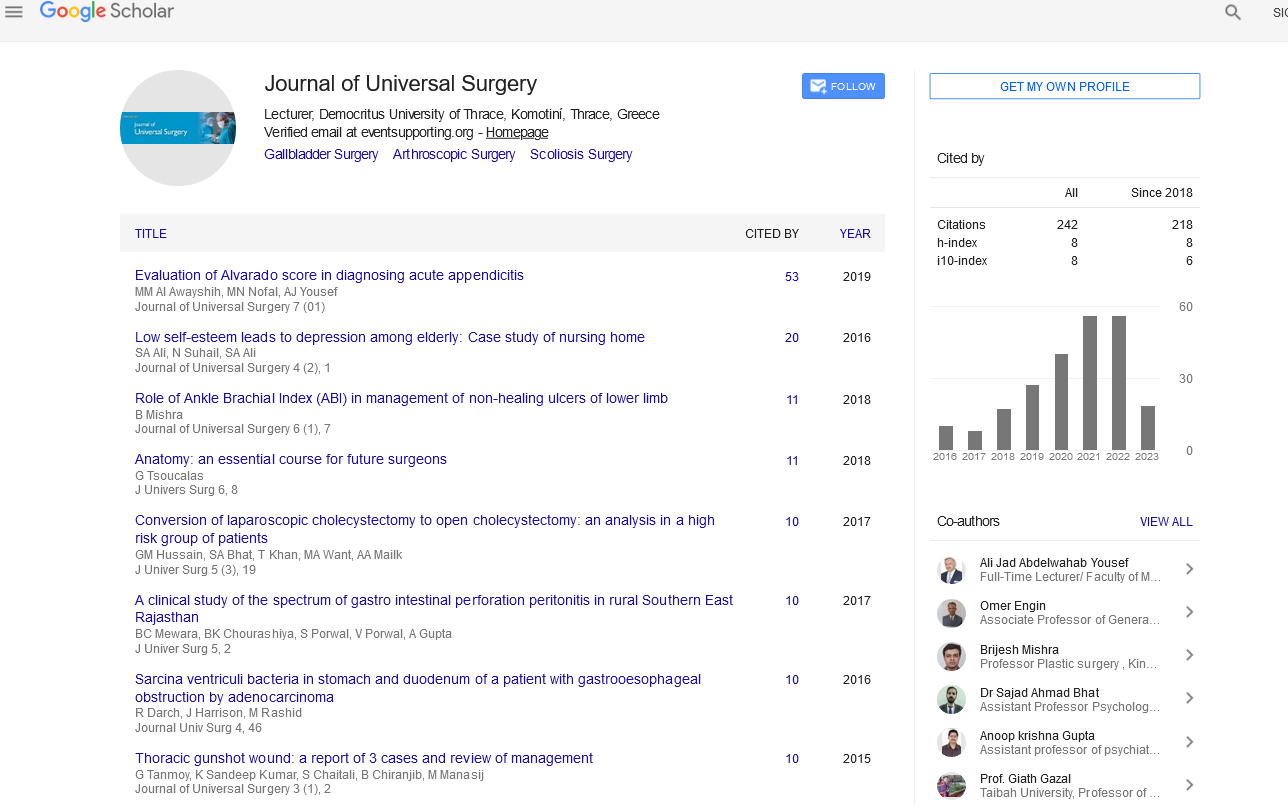Perspective - (2024) Volume 12, Issue 1
Glaucoma Surgery: Future of the Field
Martin Ferello*
Department of Opthamology, University of Cargese, Cargese, France
*Correspondence:
Martin Ferello, Department of Opthamology, University of Cargese, Cargese,
France,
Email:
Received: 16-Jan-2024, Manuscript No. IPJUS-24-14557;
Editor assigned: 19-Jan-2024, Pre QC No. IPJUS-24-14557 (PQ);
Reviewed: 02-Feb-2024, QC No. IPJUS-24-14557;
Revised: 20-Feb-2024, Manuscript No. IPJUS-24-14557 (R);
Published:
27-Feb-2024
Introduction
Glaucoma, a leading cause of irreversible blindness
worldwide, poses a significant challenge to ophthalmologists
due to its progressive nature and complex pathophysiology.
Despite the availability of various treatment modalities,
including medications and laser therapies, a considerable
number of patients continue to experience disease progression
and vision loss. For such cases, surgical intervention remains a
crucial option to Lower Intraocular Pressure (IOP) effectively and
halt disease progression. Over the years, advancements in
surgical techniques and technologies have revolutionized the
management of glaucoma, offering improved outcomes and
reduced complications. This article explores the latest
innovations in glaucoma surgery, focusing on novel techniques,
emerging technologies, and future directions in the field.
Description
Current landscape of glaucoma surgery
Traditionally, trabeculectomy and tube shunt implantation
have been the gold standard surgical procedures for glaucoma
management. Trabeculectomy involves creating a drainage
pathway to facilitate the outflow of aqueous humor, while tube
shunt implantation bypasses the trabecular meshwork to
directly lower IOP. While effective, these procedures carry the
risk of complications such as hypotony, bleb-related infections,
and late-onset fibrosis.
Minimally Invasive Glaucoma Surgeries (MIGS) have gained
popularity in recent years as they offer a safer and less invasive
alternative to traditional procedures. MIGS procedures typically
involve implanting microstents or devices to enhance aqueous
outflow while preserving the conjunctiva and minimizing tissue
trauma. Examples include the iStent, Hydrus microstent, and
Xen gel stent. These procedures are often performed in
conjunction with cataract surgery, addressing both conditions
simultaneously and improving patient outcomes.
Innovative surgical techniques
Several innovative surgical techniques have emerged to
address the limitations of traditional glaucoma surgeries and
enhance their efficacy and safety profiles. One such technique is
canaloplasty, which involves viscodilation and tensioning of Schlemm's canal to improve aqueous outflow. Canaloplasty
offers a minimally invasive approach with a lower risk of
complications compared to trabeculectomy.
Another promising technique is ab interno trabeculotomy,
also known as trabectome surgery, which involves removing a
portion of the trabecular meshwork to enhance aqueous
outflow. This approach can be performed using micro-incisional
instruments, reducing surgical trauma and improving
postoperative recovery.
Furthermore, Gonioscopy-Assisted Transluminal
Trabeculotomy (GATT) has gained traction as a minimally
invasive technique for treating various forms of glaucoma,
including angle-closure glaucoma and secondary glaucomas.
GATT involves the creation of a direct communication between
the anterior chamber and Schlemm's canal using microcatheters
under gonioscopic guidance, resulting in improved aqueous
outflow and IOP reduction.
Emerging technologies in glaucoma surgery
Advancements in technology have paved the way for the
development of innovative devices and surgical approaches
aimed at improving outcomes in glaucoma surgery. One such
technology is the use Of Micro-Invasive Glaucoma Surgery
(MIGS) devices, which are designed to lower IOP by enhancing
aqueous outflow through various mechanisms, such as
trabecular meshwork bypass, suprachoroidal drainage, or
subconjunctival drainage.
The advent of minimally invasive surgical platforms, such as
the Kahook Dual Blade (KDB) and the Omni Surgical System, has
enabled surgeons to perform precise and controlled incisions for
trabecular meshwork ablation while minimizing tissue damage.
These platforms offer customizable settings and real-time
feedback, allowing for optimized surgical outcomes and
improved patient safety.
Furthermore, advancements in imaging technology, such as
Optical Coherence Tomography (OCT) and Ultrasound
Biomicroscopy (UBM), have enhanced preoperative planning
and intraoperative visualization in glaucoma surgery. Highresolution
imaging enables surgeons to accurately identify
anatomical structures, assess surgical landmarks, and monitor
postoperative outcomes, thereby improving surgical precision
and patient care.
Future directions and challenges
Despite the significant progress in glaucoma surgery, several
challenges remain, including the need for further refinement of
surgical techniques, optimization of patient selection criteria,
and long-term evaluation of surgical outcomes. Additionally, the
integration of Artificial Intelligence (AI) and machine learning
algorithms holds promise for enhancing preoperative planning,
predicting surgical outcomes, and personalized treatment
strategies.
The development of novel biomaterials and drug delivery
systems may also revolutionize glaucoma surgery by providing
sustained IOP-lowering effects and reducing the need for
frequent interventions. Furthermore, advancements in tissue
engineering and regenerative medicine may offer alternative
approaches for repairing damaged ocular tissues and restoring
normal aqueous outflow pathways in glaucoma patients.
Conclusion
In conclusion, glaucoma surgery has witnessed remarkable
advancements in recent years, driven by innovations in surgical techniques, technologies, and interdisciplinary collaborations.
Minimally invasive approaches, such as MIGS and ab interno
procedures, offer safer and more effective alternatives to
traditional surgeries, while emerging technologies, including
micro-invasive platforms and advanced imaging modalities,
enable precise and customized treatment strategies.
Looking ahead, continued research and innovation are
essential for addressing the unmet needs in glaucoma
management, improving surgical outcomes, and enhancing the
quality of life for patients with this sight-threatening disease. By
embracing new technologies, fostering collaboration across
disciplines, and prioritizing patient-centered care, the future of
glaucoma surgery holds promise for further advancements and
breakthroughs in the field.
Citation: Ferello M (2024) Glaucoma Surgery: Future of the Field. J Univ Surg Vol.12 No.1: 009





